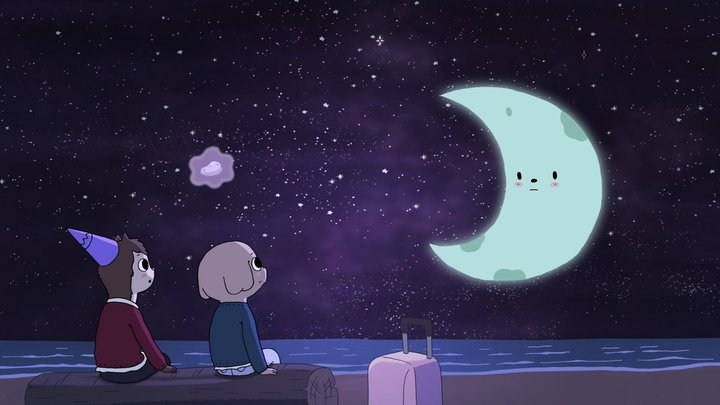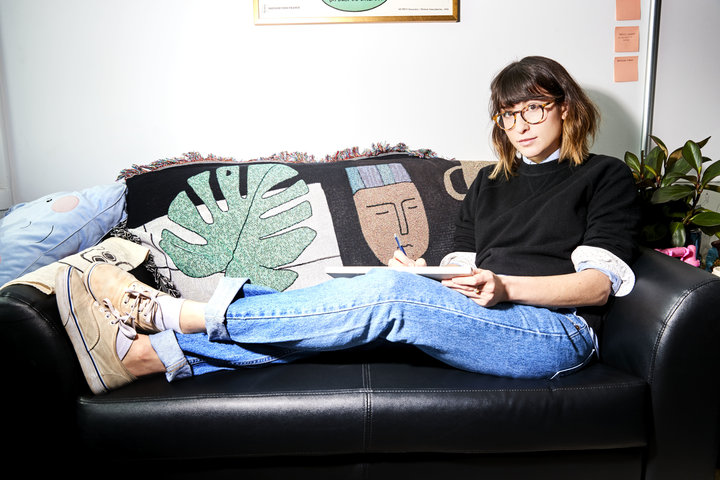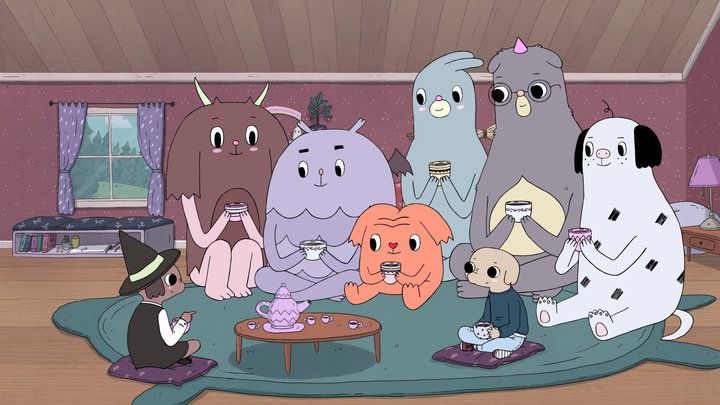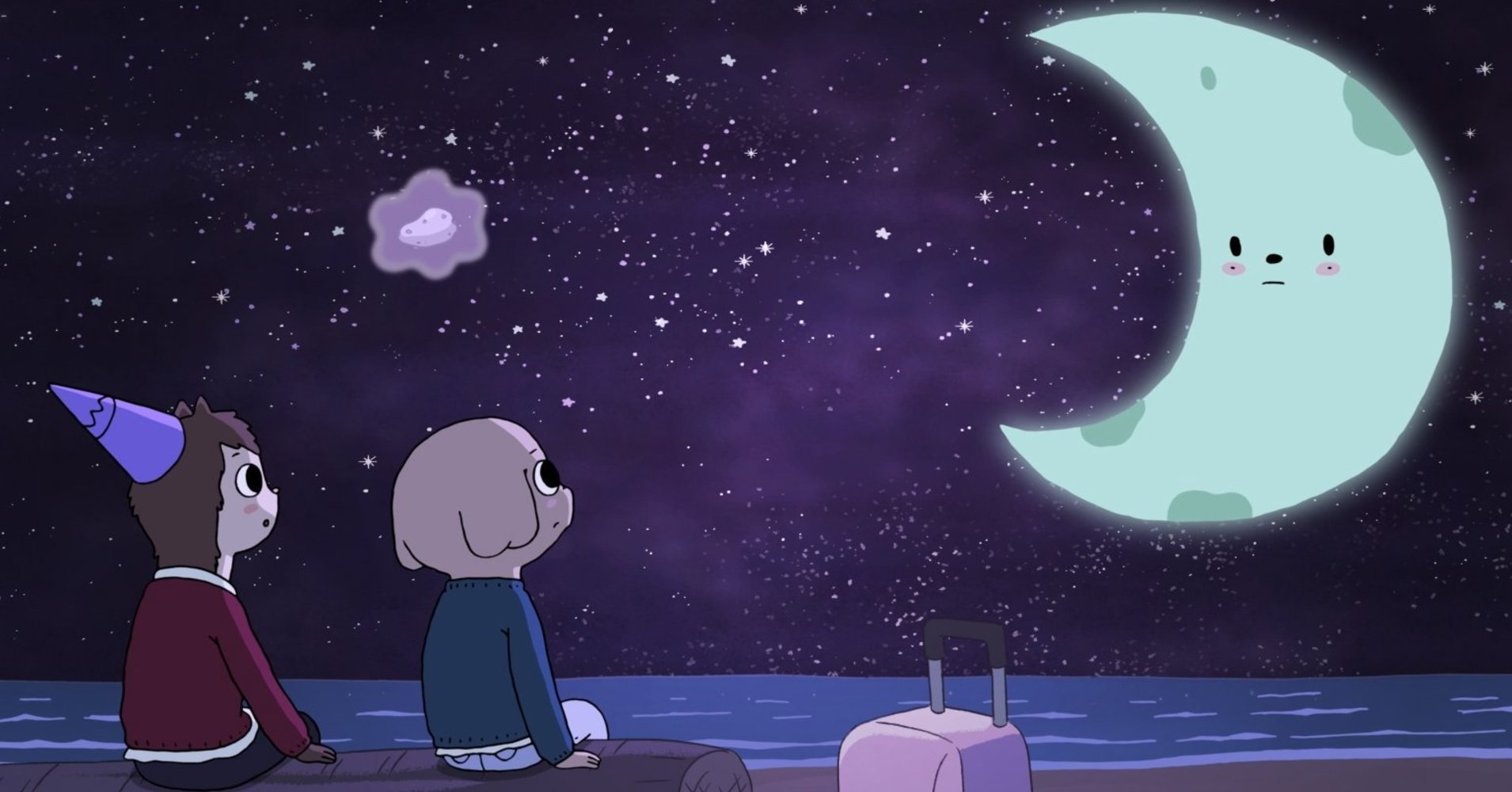[ad_1]
Ask any summer camp devotee and they’ll tell you there’s something magical about spending weeks or even months away from the confines of real life, which even for kids are nice to escape. It’s the magic that stretches time without end, transforms a stranger into a best friend in 48 hours, and lets otherwise too-cool teens and preteens unabashedly shout nonsensical camp songs while banging on mess hall tables.
That undeniable witchcraft becomes real on the Cartoon Network’s “Summer Camp Island,” an animated series that dropped all its episodes in early July. The island is inhabited by animal campers (who are voiced by kid actors), sassy teen witch counselors and a host of otherwise inanimate objects come to life. Pajamas talk, fuzzy aliens hover around, friendly yetis speak in blurts of saxophone notes, and the sun and moon smile from their respective perches (and will get mad if you lose their friendship bracelets).
The show is a delight to look at, with bright colors and soft lines that seem spiritually similar to bubbly ballpoint script in a high schooler’s notebook — or “Adventure Time,” on which “Summer Camp Island” creator Julia Pott also worked. So many things — a cloud in the sky, trees in the woods, marshmallows, a sleepy softball, a phone with arms and legs — sport two big eyes and a tiny upturned mouth. The cumulative effect feels like a warm, visual hug.
A host of recent phenomena seem linked to a desire for simple niceness: The devoted fandom of “The Great British Bake Off.” The box-office success of a documentary on Fred Rogers, the original champion of nice TV. The rise of self-care as a commonplace concept. At a time when it seems that news only gets worse and divisions among people only deepen, earnest gentleness feels like a luxury.
Pott told HuffPost in a recent conversation that her first idea for a series was “lobster ‘Gilmore Girls’” — basically the beloved WB comedy-drama but with crustaceans — and later mentioned that series as a signifier of cozy entertainment, where you know “nothing too terrible is gonna happen.”
All of the cute that “Summer Camp Island” doles out in heaps, however, doesn’t mean the show has its head in the sand. Some of its adventures are silly and lower-stakes, like a dogged journey to earn badges for yeti grooming. Others feel achingly close to real life, like the episode where the island’s monsters try to run away after learning that their exacting godmonster, who doesn’t approve of their non-child-eating lifestyles, is coming for a visit. Several episodes tackle big-time scaries relating to the fear of change or rejection.
“Growing up, my favorite things were stuff that was a little bit challenging or scary but was in this cute little bubble,” said Pott, adding, “I think wrapping it in this cute little bubble allows you to be a bit darker with your stories. … It’s already in this blanket, so you can dive in a little bit more.”
It’s that feeling — not the finger-snap poof of a spell or the island’s time-traveling quicksand — that is the real magic of the series. We talked more with Pott about her inspiration for the series, how it feels to be told your art is cute, and why she repeatedly pitched a “Muppet Babies”-style spinoff of the cartoon “Adventure Time.”

Cartoon Network
What was your initial vision for the series?
Well, the first thing I wrote down was “lobster ‘Gilmore Girls.’”
I knew I wanted it to be relatively gentle and calm, ’cause I hadn’t seen that a lot when I was a kid, and I really wanted to make something that was not too action-y, not too crazy. The original, original pitch ― because I had just moved to New York, and I was super homesick, and I wanted to write an equivalent story ― it was called “A Town Called Summer Camp.” So it wasn’t actually a summer camp; it was a town in Massachusetts called Summer Camp. All the parents in the town went to a Cher concert in the town next door, and as soon as all the parents were out of the town, the town breaks off from America and floats out into the sea. So it’s just all kids, and as soon as it’s all kids, all this magical stuff starts to come up, so there are witches and monsters and unicorns.
It was originally Oscar, the main character, misses his parents so much that he’s trying to get home the whole time. [Cartoon Network] bought it based on that pitch, but when we started developing it, they were like, this is such a bummer! “You can’t base a whole show around a kid just missing his mum all the time. That’s too sad.” I was like, yeah, that’s sad. Then it developed to be an actual summer camp that was magical. It kind of spread from there.
Yeah, I think that was the original idea. As soon as they were like, “You can’t use Cher,” I was like, “Nah! I don’t really care about this idea anymore.” [Laughs]
I feel like Cher is having a moment, so it would have been very topical.
Yeah! Now she’s in “Mamma Mia,” so she’s untouchable. She was always untouchable.
I’m curious about “lobster ‘Gilmore Girls.’” Were you envisioning two kind-of-fast-talking lobsters, like a mother and daughter?
Yeah, they’re living in a nice town near Princeton. That was the concept. It was an underwater town. It was exactly the same as “Gilmore Girls,” but they were lobsters. I think lobsters were having a moment, in my mind. I had just moved to New York and had gotten really into lobsters, so I was just like, “Yeah, ‘lobster “Gilmore Girls.”’”

Care of Cartoon Network
What influenced the art style of the show?
The main character, Oscar, was based on this elephant character from one of my short films, “Belly,” that I had done as my Royal College of Art graduation film. And he looked very, very different there than he does now. As we went through, everyone got cuter and cuter from the pilot into the final show.
Was the episode where Alice the counselor makes everything she sees cuter inspired by that process?
Oh, you mean “Monster Babies”? Actually, no, “Monster Babies” was inspired by “Muppet Babies”! When I worked on “Adventure Time,” I think there were several times where I would just jokingly suggest the idea of “Adventure Time Babies.” They were like, there will never be an “Adventure Time Babies.” [Laughs] As soon as my show got picked up, I was like, “‘Monster Babies’! It’s like ‘Muppet Babies,’ but it’s the monsters.” And it was just being able to wish-fulfill something I wanted to do for a really long time.
There’s an episode in the next batch of Season 1 that’s coming out at the end of the year. It’s not about making stuff cuter, but it’s about that feedback you get when people are like, “Oh, it’s cute,” and you immediately think that they think that it’s bad or that they’re not really seeing it. We were getting a lot of that feedback in the early stages of the show. [People were] like, “Oh, yeah, it’s really cute.” And I think I was being a little bit downtrodden, so we made a whole episode revolving around that, about one character making something cute and no one really caring and him realizing that it doesn’t matter.
Did you not want the show to be seen as cute?
When I first started getting that feedback, when people were like, “Yeah, it’s cute,” it feels like it’s kind of shutting you down and saying it’s just this one thing. Or it feels like your art is less-than because it’s cute. I think the lesson that I learned, the longer I worked on it, was, “Oh, I want it to be cute. That’s what I like about it and I think that’s charming. I really love it and that’s all that matters.”
I think as we get into deeper stories that skew a little darker sometimes, it’s nice that it’s cute because it packages it in a much softer world. And it turns out that that softness and that gentleness that we put in there are what people are responding to, which is really nice, which is what we wanted.
I feel like the show fits into this category of things being cute at a level that’s not just looking at something cute, but it’s this feeling of being overwhelmed by cute and wanting to soak in the cuteness. What do you think of that characterization?
I mean, I would be very happy if it did. I feel like we’re getting to this pocket of media and things in general where everyone wants to feel gentle and soft and see cute things and sort of have a little respite from the world and just feel like … like, “Gilmore Girls” isn’t cute, but I’d put it in a similar category [of] nothing too terrible is gonna happen. It feels quite cozy and it’s like being under a blanket to watch this. … You always think it’s teenage or it’s childlike to describe something as cute. I think being wrapped up in cuteness is just very much the best and something that should be celebrated.

Cartoon Network
So many episodes seem to tackle fears. Is that something you wanted to play against the visuals of the show?
Yeah, I think that was definitely what we were going for. Growing up, my favorite things were stuff that was a little bit challenging or scary but was in this cute little bubble. “Gremlins” was my favorite movie, ’cause it has these cute little furry characters, but it’s also got this like extra layer. … Or things that are cozy sci-fi, like “Twin Peaks,” where you’re not expecting to feel scared or deal with fear.
I think wrapping it in this cute little bubble allows you to be a bit darker with your stories or explore something that’s maybe a more specific emotion that might not be so pleasant. It’s already in this blanket, so you can dive in a little bit more. It’s sort of welcoming.
I think with kids especially — I think Maurice Sendak talked about this a lot — when you’re a kid, it’s good to see scary stuff in a safe environment, so you learn that when you encounter scary things later, it’s not so bad and I can handle it. … It’s a safe place at home that you can watch this cozy show where it’s like, oh, this is a subject that’s a little scarier, but you’re safe and it’s a cozy little world for you to look at it in.
Where do things like Oscar’s talking pajamas come from?
They’re kind of supposed to be his subconscious or his id, like everything that he wants or his most innocent child self is thinking but is afraid to express. So that’s sort of that character, and then Susie [a counselor] also has a pair of talking pajamas that has a similar vibe.
The original pair of pajamas was voiced by my ex-boyfriend’s niece. She sort of became a big inspiration for that character. They would sit down and record her and she would just say anything she was thinking, and she was just so cute and so smart. It was inspired a lot by things like Catbug from “Bravest Warriors,” like having kids just speaking and saying charming things and basing it off of that.
A lot of the characters are voiced by kids, right?
Yeah, most of the cast is kids. All the monsters are adults, but all the kids’ characters are voiced by kids, which is something we really wanted to do and we talked a lot about because, obviously, kids grow up and that could be a problem for casting. You get so many surprises, and their voices are so charming, and sometimes they’ll say something in an inflection that isn’t right, and we’ll use it because it’s just the cutest thing.
Also writing lines, especially for pajamas — they’re a little bit more chewy in dialogue, there’s more to say. It’s really fun to hear a 4-year-old like say really intelligent things. And she’s so smart and she knows how to say everything. She re-writes some of our sentences sometimes ’cause she thinks it’s better that way.
[ad_2]
Source link

